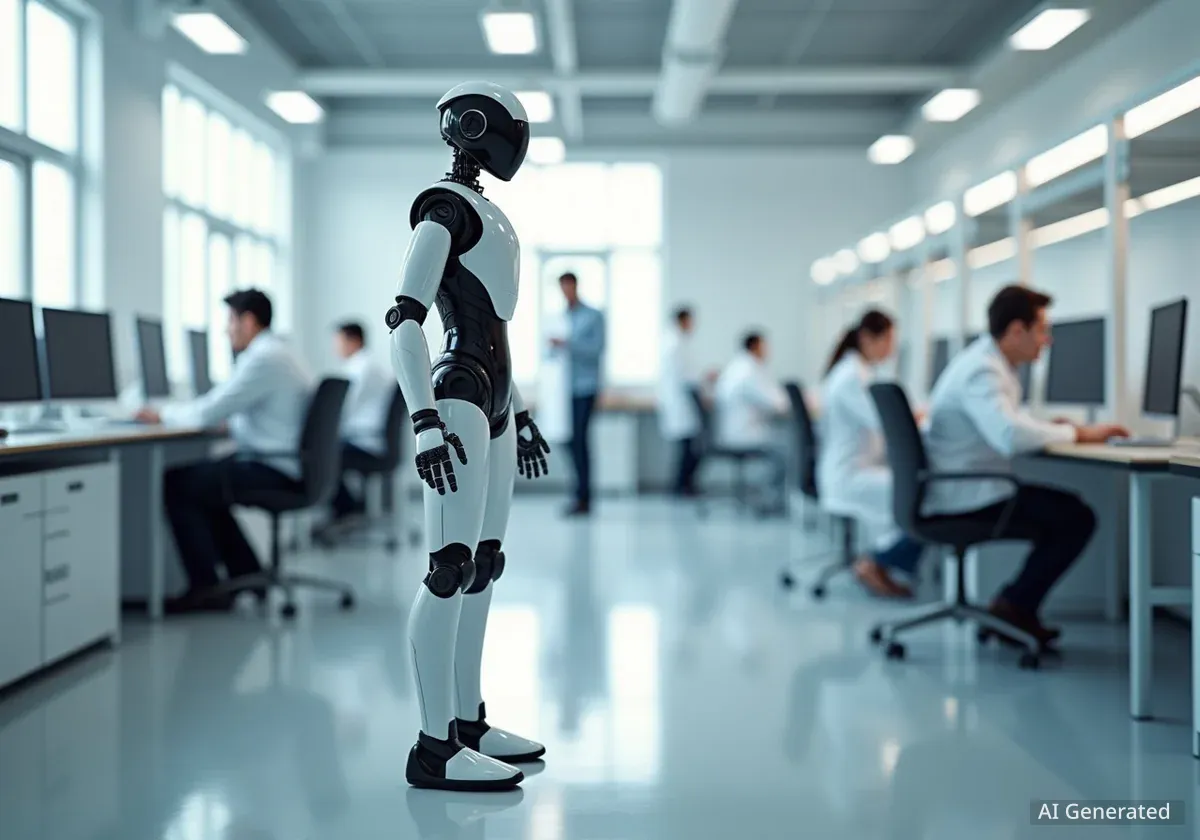Chinese company Unitree Robotics has introduced the R1, a bipedal humanoid robot with a starting price of just $5,900. Launched in July, the new robot is designed to make advanced robotics research and development more accessible to educators, researchers, and software developers.
The R1 weighs 55 pounds and features integrated artificial intelligence for tasks like voice recognition and image processing. Its capabilities, including running and performing cartwheels, signal a significant step in creating affordable and dynamic humanoid platforms for a wider market.
Key Takeaways
- Unitree Robotics has released the R1, a bipedal humanoid robot, with a starting price of $5,900.
- The robot is targeted at researchers, educators, and developers for AI and robotics projects.
- It weighs 55 pounds and is equipped with 26 joints, enabling complex movements like running and boxing.
- The R1's low price point could significantly lower the barrier to entry for advanced humanoid robotics research.
A New Price Point for Humanoid Robotics
The field of humanoid robotics has long been dominated by expensive, highly specialized machines often costing hundreds of thousands or even millions of dollars. Unitree Robotics aims to change this landscape with the introduction of its R1 model. At a starting price of $5,900, the R1 is positioned to democratize access to this advanced technology.
This aggressive pricing strategy contrasts sharply with other well-known humanoid robots developed for research and industrial applications. By making the platform more affordable, Unitree is opening the door for smaller universities, independent developers, and educational institutions to experiment with technologies that were previously out of reach.
The primary audience for the R1 is not the consumer market but rather the technical community. It serves as a programmable platform for testing new software, developing AI algorithms for human-robot interaction, and studying bipedal locomotion. This focus on research and development is crucial for advancing the entire field.
Who is Unitree Robotics?
Based in China, Unitree Robotics is not a newcomer to the robotics industry. The company gained international recognition for its series of quadruped (four-legged) robots, often compared to Boston Dynamics' Spot. Their products, like the Go series, are known for offering robust performance at a fraction of the cost of their competitors, a strategy they are now applying to the humanoid robot market with the R1.
Technical Specifications and Capabilities
The Unitree R1 is a compact and relatively lightweight humanoid robot. It stands as an example of efficient engineering designed to balance cost with performance. Its physical and technical attributes are tailored for a research and development environment.
Physical Design and Articulation
Weighing just 55 pounds (approximately 25 kilograms), the R1 is manageable for small teams and labs. Its mobility is powered by 26 high-performance joints. While this is significantly fewer than the approximately 300 joints found in the human body, it is sufficient to replicate a wide range of human-like movements.
These joints allow the robot to demonstrate impressive agility. Unitree has showcased the R1 performing dynamic actions such as running, boxing, and even executing a cartwheel. Such maneuvers require sophisticated balance, coordination, and power control, indicating a well-engineered hardware and software system.
Human vs. Robot Joints
The human body has around 300 joints, providing incredible flexibility and range of motion. The R1's 26 joints are strategically placed in its legs, arms, and torso to maximize mobility and mimic key human movements for research purposes, prioritizing function over exact biological replication.
Integrated AI and Sensory Input
A key feature of the R1 is its built-in artificial intelligence. The robot comes equipped with onboard processing that supports voice recognition and image processing. This allows developers to create applications where the robot can interact with its environment and respond to verbal commands without needing constant connection to an external computer.
This integrated AI makes the R1 a self-contained platform for testing algorithms related to navigation, object recognition, and human interaction. For educators, it provides a practical tool for teaching students the principles of AI and robotics in a hands-on manner.
The Impact on Research and Education
The availability of an affordable, programmable humanoid robot like the R1 could have a substantial impact on several sectors. Its primary influence will likely be felt in academic research and technical education, where budget constraints often limit access to cutting-edge hardware.
- Academic Research: University labs can use the R1 to study complex problems in bipedal walking, dynamic balancing, and safe human-robot collaboration without needing massive grants.
- Software Development: AI developers can test new control algorithms on a physical robot, providing real-world feedback that simulations cannot fully replicate.
- Education: In STEM programs, the R1 can serve as an engaging platform to teach students about programming, mechanics, and artificial intelligence, inspiring the next generation of roboticists.
By lowering the cost of entry, Unitree is effectively creating a larger community of developers and researchers. This could accelerate innovation as more people contribute new ideas, software, and applications for humanoid robots.
The Broader Robotics Context
For years, the public image of robots has been shaped by science fiction's humanoid figures, but the reality has been dominated by specialized machines. Drones, robotic arms in factories, and autonomous vacuum cleaners are far more common because they are designed for specific tasks.
However, there is a growing push towards creating general-purpose humanoid robots that can operate in environments designed for humans. Companies like Tesla with its Optimus robot, Figure AI, and Boston Dynamics are all working on sophisticated humanoids intended for labor and assistance. The R1, while not directly competing with these industrial-grade robots, plays a crucial role in building the foundational software and expertise needed for this future.
"The introduction of an affordable platform like the R1 is less about immediate commercial application and more about building the ecosystem. When thousands of developers can get their hands on a humanoid robot, the pace of software innovation will skyrocket." - Industry Analyst
The R1 represents a different philosophy: instead of building a single, perfect robot, Unitree is providing the tools for a global community to experiment and innovate collectively. This approach has been successful in other tech sectors, such as personal computing and 3D printing, and could prove to be a pivotal strategy in the evolution of robotics.
While the R1 may not be stocking shelves or assisting in homes tomorrow, its arrival marks an important moment. It signals that the era of accessible, advanced robotics is beginning, promising to accelerate a future where humanoid robots move from science fiction into practical reality.





